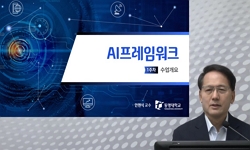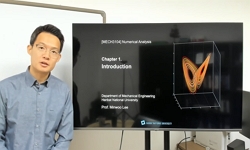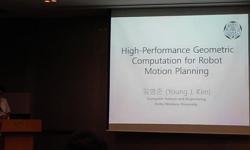As the performance of computers increases, the use of deep learning, which has faced technical limitations in the past, is becoming more diverse. In many fields, deep learning has contributed to the creation of added value and used on the bases of mor...
http://chineseinput.net/에서 pinyin(병음)방식으로 중국어를 변환할 수 있습니다.
변환된 중국어를 복사하여 사용하시면 됩니다.
- 中文 을 입력하시려면 zhongwen을 입력하시고 space를누르시면됩니다.
- 北京 을 입력하시려면 beijing을 입력하시고 space를 누르시면 됩니다.
https://www.riss.kr/link?id=A106028666
- 저자
- 발행기관
- 학술지명
- 권호사항
-
발행연도
2019
-
작성언어
Korean
- 주제어
-
KDC
004
-
등재정보
KCI등재
-
자료형태
학술저널
- 발행기관 URL
-
수록면
137-143(7쪽)
-
KCI 피인용횟수
0
- DOI식별코드
- 제공처
-
0
상세조회 -
0
다운로드
부가정보
다국어 초록 (Multilingual Abstract)

As the performance of computers increases, the use of deep learning, which has faced technical limitations in the past, is becoming more diverse. In many fields, deep learning has contributed to the creation of added value and used on the bases of more data as the application become more divers. The process for obtaining a better performance model will require a longer time than before, and therefore it will be necessary to find an optimal model that shows the best performance more quickly. In the artificial neural network modeling a tuning process that changes various elements of the neural network model is used to improve the model performance. Except Gride Search and Manual Search, which are widely used as tuning methods, most methodologies have been developed focusing on heuristic algorithms. The heuristic algorithm can get the results in a short time, but the results are likely to be the local optimal solution. Obtaining a global optimal solution eliminates the possibility of a local optimal solution. Although the Brute Force Method is commonly used to find the global optimal solution, it is not applicable because of an infinite number of hyper parameter combinations. In this paper, we use a statistical technique to reduce the number of possible cases, so that we can find the global optimal solution.
참고문헌 (Reference)
1 C. Paar, "Understanding cryptography : a textbook for students and practitioners" Springer Science & Business Media 7-, 2009
2 H. K. Lam, "Tuning of the structure and parameters of neural network using an improved genetic algorithm" 25-30, 2001
3 A. Graves, "Supervised sequence labelling with recurrent neural networks" Springer 35-42, 2012
4 R. Socher, "Recursive deep models for semantic compositionality over a sentiment treebank" 1631-1642, 2013
5 T. Mikolov, "Recurrent neural network based language model" 2010
6 J. Bergstra, "Random search for hyper-parameter optimization" 13 : 281-305, 2012
7 R. V. Hogg, "Probability and statistical inference" Pearson Educational International 204-205, 2015
8 J. Snoek, "Practical bayesian optimization of machine learning algorithms" 2951-2959, 2012
9 B. Qolomany, "Parameters optimization of deep learning models using particle swarm optimization" 1285-1290, 2017
10 S. Hochreiter, "Long short-term memory" 9 (9): 1735-1780, 1997
1 C. Paar, "Understanding cryptography : a textbook for students and practitioners" Springer Science & Business Media 7-, 2009
2 H. K. Lam, "Tuning of the structure and parameters of neural network using an improved genetic algorithm" 25-30, 2001
3 A. Graves, "Supervised sequence labelling with recurrent neural networks" Springer 35-42, 2012
4 R. Socher, "Recursive deep models for semantic compositionality over a sentiment treebank" 1631-1642, 2013
5 T. Mikolov, "Recurrent neural network based language model" 2010
6 J. Bergstra, "Random search for hyper-parameter optimization" 13 : 281-305, 2012
7 R. V. Hogg, "Probability and statistical inference" Pearson Educational International 204-205, 2015
8 J. Snoek, "Practical bayesian optimization of machine learning algorithms" 2951-2959, 2012
9 B. Qolomany, "Parameters optimization of deep learning models using particle swarm optimization" 1285-1290, 2017
10 S. Hochreiter, "Long short-term memory" 9 (9): 1735-1780, 1997
11 R. E. Korf, "Depth-first iterative-deepening: An optimal admissible tree search" 27 (27): 97-109, 1985
12 L. Deng, "Deep learning : methods and applications" 7 (7): 197-387, 2014
13 T. Pukkala, "A heuristic optimization method for forest planning and decision making" 8 (8): 560-570, 1993
14 C. Zhang, "A compound structure of ELM based on feature selection and parameter optimization using hybrid backtracking search algorithm for wind speed forecasting" 143 : 360-376, 2017
15 Y. Xia, "A boosted decision tree approach using Bayesian hyper-parameter optimization for credit scoring" 78 : 225-241, 2017
16 A. Tharwat, "A ba-based algorithm for parameter optimization of support vector machine" 93 : 13-22, 2017
동일학술지(권/호) 다른 논문
-
- 한국컴퓨터정보학회
- Jeong-Rang Kim(김정랑)
- 2019
- KCI등재
-
Implementation of a Wi-Fi Based Cluster System using Raspberry Pi for Multidisciplinary Education
- 한국컴퓨터정보학회
- Geum-Seo Koo(구금서)
- 2019
- KCI등재
-
Pest Control System using Deep Learning Image Classification Method
- 한국컴퓨터정보학회
- Backsan Moon(문백산)
- 2019
- KCI등재
-
Comparative analysis of US and China artificial intelligence patents trends
- 한국컴퓨터정보학회
- Daejung Kim(김대중)
- 2019
- KCI등재
분석정보
인용정보 인용지수 설명보기
학술지 이력
| 연월일 | 이력구분 | 이력상세 | 등재구분 |
|---|---|---|---|
| 2026 | 평가예정 | 재인증평가 신청대상 (재인증) | |
| 2020-01-01 | 평가 | 등재학술지 유지 (재인증) |  |
| 2017-01-01 | 평가 | 등재학술지 유지 (계속평가) |  |
| 2013-01-01 | 평가 | 등재학술지 유지 (등재유지) |  |
| 2010-01-01 | 평가 | 등재학술지 유지 (등재유지) |  |
| 2007-01-01 | 평가 | 등재학술지 선정 (등재후보2차) |  |
| 2006-01-01 | 평가 | 등재후보 1차 PASS (등재후보1차) |  |
| 2004-07-01 | 평가 | 등재후보학술지 선정 (신규평가) |  |
학술지 인용정보
| 기준연도 | WOS-KCI 통합IF(2년) | KCIF(2년) | KCIF(3년) |
|---|---|---|---|
| 2016 | 0.44 | 0.44 | 0.44 |
| KCIF(4년) | KCIF(5년) | 중심성지수(3년) | 즉시성지수 |
| 0.43 | 0.38 | 0.58 | 0.15 |




 ScienceON
ScienceON DBpia
DBpia






